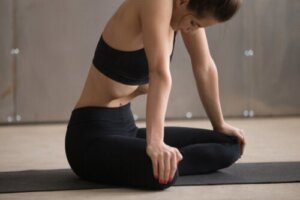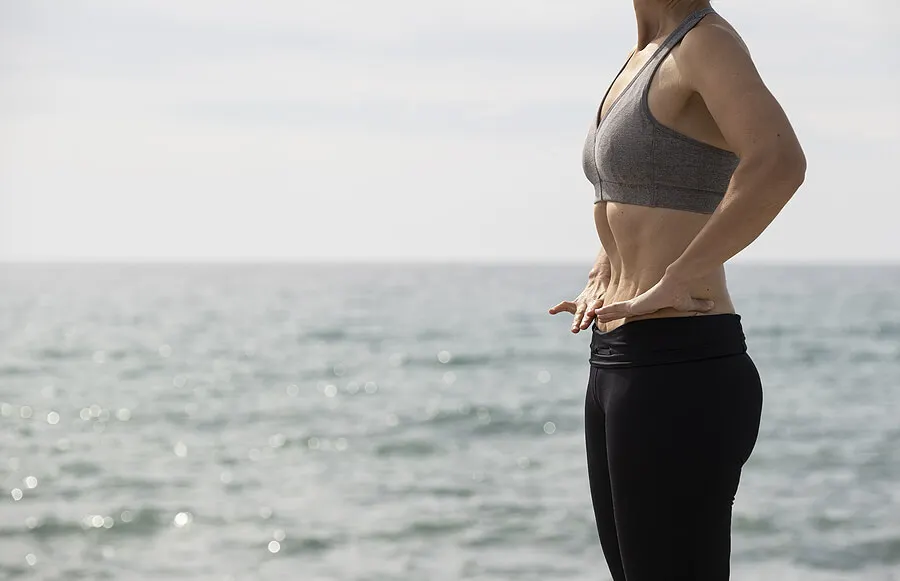What Is the Low Pressure Fitness Method and What Are its Benefits?

High-intensity training is the most popular when it comes to physical activity. However, techniques have emerged that propose the opposite. However, the goal of these is not to replace conventional exercise, but to complement it. Read on to find out what the low pressure fitness method is and its benefits.
It’s a type of training that connects the body and mind. The activity conceives the body in a global way and special emphasis is placed on posture and breathing.
This is a low-intensity activity that can be performed by anyone, regardless of their age, sex, or physical condition. The technique emerged in 2014 as an evolution of hypopressive abdominals.
Oxygenation and postural correction are fundamental pillars of this revolutionary method.
The main benefits of low pressure fitness training
Low pressure fitness training allows us to focus the work on the abdominal area and belly effectively and safely. This helps us to achieve greater stability, strengthen the muscles, and obtain better blood circulation, in addition to avoiding injuries.
On the other hand, by working on our breathing, a synergy is generated between the body and mind, as happens in yoga. This allows us to be more relaxed and helps to reduce our stress levels.
It strengthens the abdomen
The abdominal muscles are key for their stabilizing function of the spine. This allows us to have a better posture and achieve higher levels of strength and endurance.
A correct body position is essential when performing any exercise or competitive actions. On the other hand, it plays an undeniable aesthetic role, beyond the many health benefits it brings.

We think you may be interested in reading this, too: Trent Alexander-Arnold: The Vision at the Heart of His Training Sessions
It improves breathing
Breathing exercises help to release tension, which also increases our capacity to breathe in and out. Good lung capacity has a positive impact on physical performance.
Breathing work is often neglected in sports training. However, it’s one of the fundamental aspects to improve and recover faster.
In fact, in a study on how physical fitness contributes to cardiorespiratory synchronization, longer synchronization episodes were observed in athletes than in sedentary people. This corroborates previous research on spontaneous breathing.
It increases aerobic capacity
Low pressure fitness training allows us to have a greater capacity for resistance to effort. It does this by increasing oxygenation of the muscles, which translates into less fatigue. The exercises are performed in low-volume respiratory apnea. That means that we leave the lungs without air and a rib opening is performed to reduce the pressure in the abdomen.
The apneas are performed alternately with breathing techniques to generate intermittent hypoxia work. This technique is applied to improve oxygen transport in the body.
It strengthens the pelvic floor
Hypopressive exercises are key to strengthening the pelvic floor, as they reduce pressure in the abdomen, cause proper contraction, and help tone the perineal musculature.
This is important to prevent disorders such as urinary incontinence, pain in the area, and, in the case of men, erectile dysfunction.
It prevents joint and muscle injuries
With low pressure fitness training, by increasing muscle tone and working the middle zone, the joints are also strengthened. This allows us greater mobility and helps us to support more loads in training and withstand high-intensity efforts.
Thus, it can also help us to prevent possible injuries such as sprains or strains, which are very common in sports practices. In addition, it can help prevent the muscular discomfort that usually appears during or after training.
It acts against stress
Breathing techniques help us to relax and reduce anxiety and stress levels. If we can perform controlled breathing, we can lower our heart rate and improve our nervous system.
According to a study published in 2020, aerobic, resistance, and mind/body exercise are also effective to mitigate the symptoms of depression in adults.

The three basic exercises in low pressure fitness training
These are some exercises that you’ll surely begin to practice in the initial level of this technique:
- Venus: This consists of standing and keeping your spine straight and stretched. Your gaze should remain straight ahead, and your shoulders and arms are stretched upwards as if you were holding the ceiling. In this position, you should take three deep breaths, and then maintain a rib opening for 10 seconds.
- Maya: In a four-legged position, your forearms should be resting on the floor and your hips should be in line with your knees. Then, you bend your spine and lower your head as if you were going to look at your navel. After, take three belly breaths until your lungs are empty and keep the rib opening for 10 seconds, as in the previous exercise.
- Asymmetrical demeter: This is ideal to end the day, as it allows you to stretch your entire spine. You must lie on our back, with your arms and legs extended. Then, take air through your nose to expand your rib cage and expel it through your mouth gently. Finally, open your rib cage for 10 seconds.
Like this article? You may also like to read: The 10 Best Speed Exercises to Improve Your Performance
Clear your mind and achieve the ideal balance for your life
The low pressure fitness method serves as a complement to high intensity training. The combination of exercises with breathing techniques will allow you to clear your mind and strengthen your muscles, mainly in the abdomen and pelvis.
It’s a good idea to have a medical checkup before starting the practice, as well as to consult a professional to adapt the training to your needs. Otherwise, it’s a low-intensity practice with no contraindications.
All cited sources were thoroughly reviewed by our team to ensure their quality, reliability, currency, and validity. The bibliography of this article was considered reliable and of academic or scientific accuracy.
- Perry S, Khovanova N, Khovanov I. Physical fitness contributes to cardio-respiratory synchronization. Annu Int Conf IEEE Eng Med Biol Soc. 2019 Jul;2019:4957-4960. doi: 10.1109/EMBC.2019.8857193. PMID: 31946972. Disponible en: https://pubmed.ncbi.nlm.nih.gov/31946972/
- Miller KJ, Areerob P, Hennessy D, Gonçalves-Bradley DC, Mesagno C, Grace F. Aerobic, resistance, and mind-body exercise are equivalent to mitigate symptoms of depression in older adults: A systematic review and network meta-analysis of randomised controlled trials. F1000Res. 2020 Nov 13;9:1325. doi: 10.12688/f1000research.27123.2. PMID: 34158928; PMCID: PMC8191520. Disponible en: https://pubmed.ncbi.nlm.nih.gov/34158928/
This text is provided for informational purposes only and does not replace consultation with a professional. If in doubt, consult your specialist.








